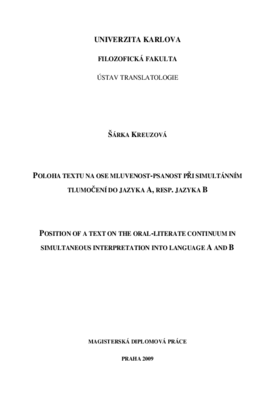Poloha textu na ose mluvenost-psanost při simultánním tlumočení do jazyka A, resp. jazyka B
Position of a text on the oral-literate continuum in simultaneous interpreting into language A and B
diploma thesis (DEFENDED)

View/
Permanent link
http://hdl.handle.net/20.500.11956/25915Identifiers
Study Information System: 75150
Collections
- Kvalifikační práce [23212]
Author
Advisor
Referee
Čeňková, Ivana
Faculty / Institute
Faculty of Arts
Discipline
Italian Studies - MA in Translation and Interpreting: English
Department
Institute of Translation Studies
Date of defense
21. 9. 2009
Publisher
Univerzita Karlova, Filozofická fakultaLanguage
Czech
Grade
Excellent
Cílem této teoreticko-empirické práce bylo zkoumat, zda a případně jak se mění poloha textu na ose mluvenost-psanost v procesu simultánního tlumočení a zda je tato změna podmíněna směrem tlumočení, tj. zda se liší při tlumočení do jazyka A a do jazyka B. V této práci jsme navázali na podobný experiment, který byl obsahem magisterské diplomové práce Miriam Shlesingerové (1989). Naše zkoumání však bylo provedeno na odlišném jazykovém materiálu (výchozím jazykem byla vždy čeština, cílovým jazykem angličtina) a oproti původní práci rozšířeno o výše zmíněný aspekt směru tlumočení. V teoretické části této práce jsme se zaměřili na dvojí problematiku. První oddíl byl věnován otázce mluvenosti a psanosti a v něm jsme se pokusili o syntézu dosavadních poznatků o této problematice. Definovali jsme pojmy mluvenost a psanost z různých hledisek a také jsme se věnovali rozdílům mezi texty psanými a mluvenými na jedné straně, a texty s vysokou mírou psanosti a s vysokou mírou mluvenosti na straně druhé. Závěr tohoto oddílu byl věnován charakteristickým rysům textů s vysokou mírou psanosti a textů s vysokou mírou mluvenosti.
The aim of this theoretical/empirical study was to observe whether and how the position of a text on the oral-literate continuum changes in simultaneous interpretation and to find out whether this change is dependent on the direction of interpreting, i.e. whether it is different when interpreting into language A and language B. The study was inspired by a similar experiment, presented as an M.A. thesis by Miriam Shlesinger in 1989. However, this study was carried out using a different language combination (Czech being the source and English being the target language in all cases). Compared to Shlesinger's study, the above-mentioned aspect of directionality of interpreting was also incorporated. In the theoretical part, attention was focused on two main areas. The first one was the area of orality and literacy. In this section, an attempt was made to synthesize the existing information about this subject. The terms 'orality' and 'literacy' were defined from different points of view and the differences between spoken and written texts on the one hand, and oral and literate text on the other hand, were described. At the end of this section the characteristic features of literate and oral texts were discussed.
